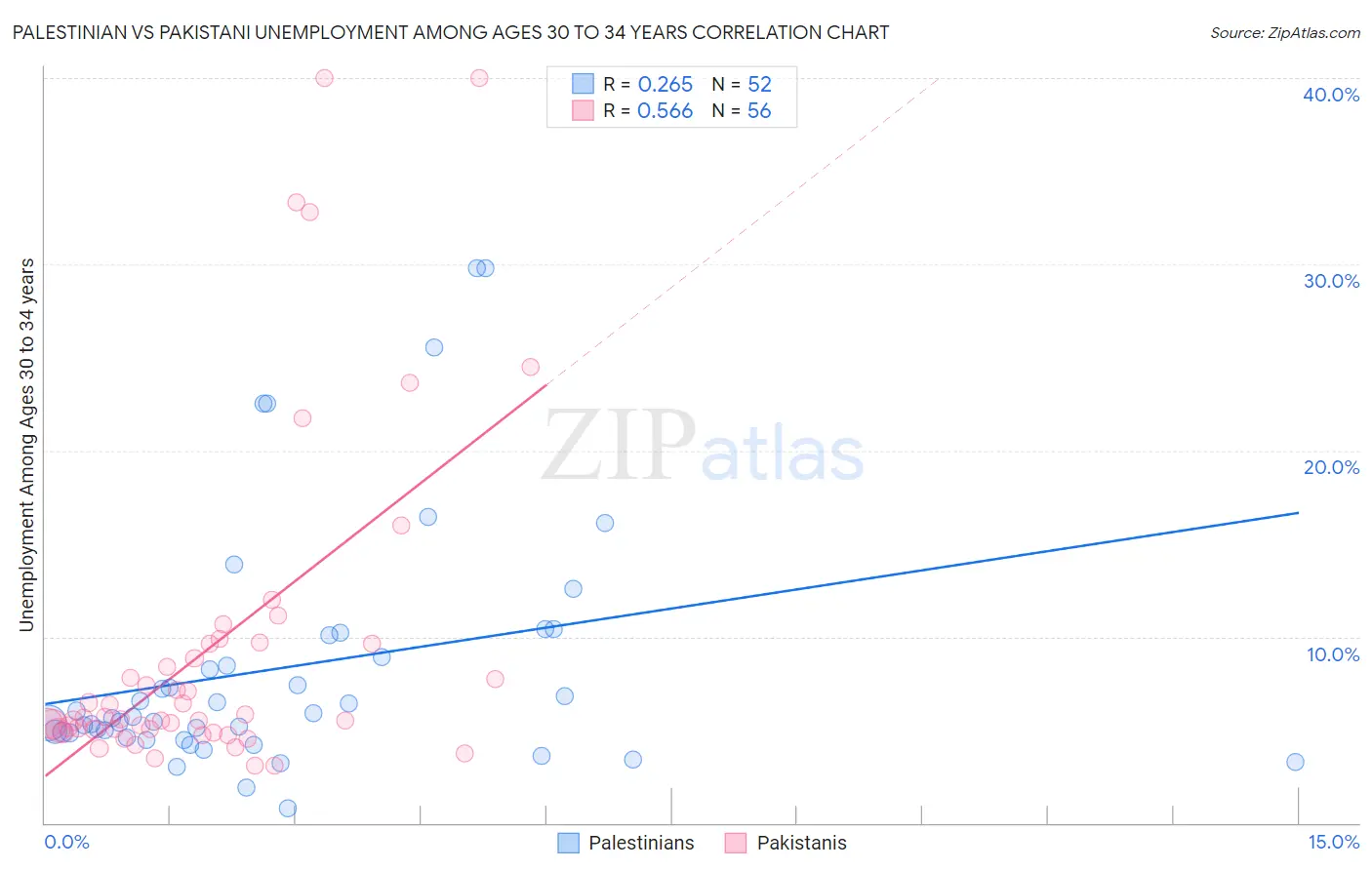Palestinian vs Pakistani Unemployment Among Ages 30 to 34 years
COMPARE
Palestinian
Pakistani
Unemployment Among Ages 30 to 34 years
Unemployment Among Ages 30 to 34 years Comparison
Palestinians
Pakistanis
5.4%
UNEMPLOYMENT AMONG AGES 30 TO 34 YEARS
75.1/ 100
METRIC RATING
135th/ 347
METRIC RANK
5.4%
UNEMPLOYMENT AMONG AGES 30 TO 34 YEARS
74.6/ 100
METRIC RATING
136th/ 347
METRIC RANK
Palestinian vs Pakistani Unemployment Among Ages 30 to 34 years Correlation Chart
The statistical analysis conducted on geographies consisting of 210,568,596 people shows a weak positive correlation between the proportion of Palestinians and unemployment rate among population between the ages 30 and 34 in the United States with a correlation coefficient (R) of 0.265 and weighted average of 5.4%. Similarly, the statistical analysis conducted on geographies consisting of 320,853,803 people shows a substantial positive correlation between the proportion of Pakistanis and unemployment rate among population between the ages 30 and 34 in the United States with a correlation coefficient (R) of 0.566 and weighted average of 5.4%, a difference of 0.050%.

Unemployment Among Ages 30 to 34 years Correlation Summary
| Measurement | Palestinian | Pakistani |
| Minimum | 0.80% | 3.1% |
| Maximum | 29.8% | 40.0% |
| Range | 29.0% | 36.9% |
| Mean | 8.3% | 9.4% |
| Median | 5.7% | 5.6% |
| Interquartile 25% (IQ1) | 4.7% | 5.0% |
| Interquartile 75% (IQ3) | 9.5% | 9.6% |
| Interquartile Range (IQR) | 4.8% | 4.6% |
| Standard Deviation (Sample) | 6.7% | 8.9% |
| Standard Deviation (Population) | 6.6% | 8.8% |
Demographics Similar to Palestinians and Pakistanis by Unemployment Among Ages 30 to 34 years
In terms of unemployment among ages 30 to 34 years, the demographic groups most similar to Palestinians are Immigrants from Canada (5.4%, a difference of 0.050%), Bangladeshi (5.3%, a difference of 0.14%), Serbian (5.4%, a difference of 0.20%), Carpatho Rusyn (5.3%, a difference of 0.21%), and Immigrants from Northern Europe (5.3%, a difference of 0.21%). Similarly, the demographic groups most similar to Pakistanis are Immigrants from Canada (5.4%, a difference of 0.0%), Serbian (5.4%, a difference of 0.16%), Bangladeshi (5.3%, a difference of 0.19%), Lithuanian (5.4%, a difference of 0.20%), and Immigrants from North America (5.4%, a difference of 0.22%).
| Demographics | Rating | Rank | Unemployment Among Ages 30 to 34 years |
| Greeks | 80.4 /100 | #125 | Excellent 5.3% |
| Immigrants | Sri Lanka | 80.2 /100 | #126 | Excellent 5.3% |
| Taiwanese | 79.4 /100 | #127 | Good 5.3% |
| Immigrants | Uruguay | 79.3 /100 | #128 | Good 5.3% |
| Poles | 78.8 /100 | #129 | Good 5.3% |
| Germans | 77.8 /100 | #130 | Good 5.3% |
| Immigrants | Eastern Europe | 77.4 /100 | #131 | Good 5.3% |
| Carpatho Rusyns | 77.3 /100 | #132 | Good 5.3% |
| Immigrants | Northern Europe | 77.3 /100 | #133 | Good 5.3% |
| Bangladeshis | 76.6 /100 | #134 | Good 5.3% |
| Palestinians | 75.1 /100 | #135 | Good 5.4% |
| Pakistanis | 74.6 /100 | #136 | Good 5.4% |
| Immigrants | Canada | 74.6 /100 | #137 | Good 5.4% |
| Serbians | 72.9 /100 | #138 | Good 5.4% |
| Lithuanians | 72.4 /100 | #139 | Good 5.4% |
| Immigrants | North America | 72.2 /100 | #140 | Good 5.4% |
| Immigrants | Europe | 72.1 /100 | #141 | Good 5.4% |
| Immigrants | Greece | 72.0 /100 | #142 | Good 5.4% |
| Russians | 71.1 /100 | #143 | Good 5.4% |
| Immigrants | Russia | 71.0 /100 | #144 | Good 5.4% |
| Syrians | 70.3 /100 | #145 | Good 5.4% |